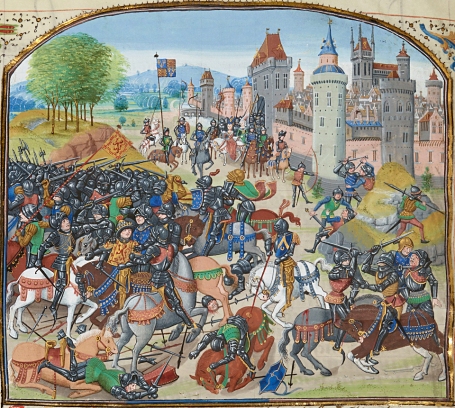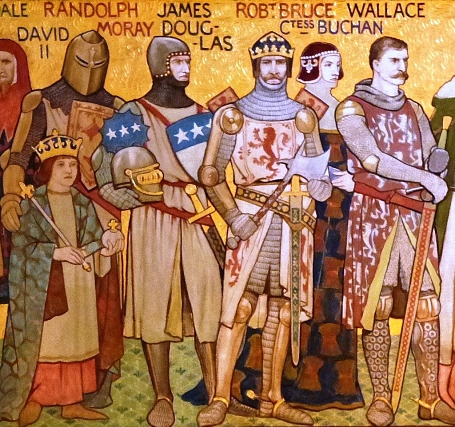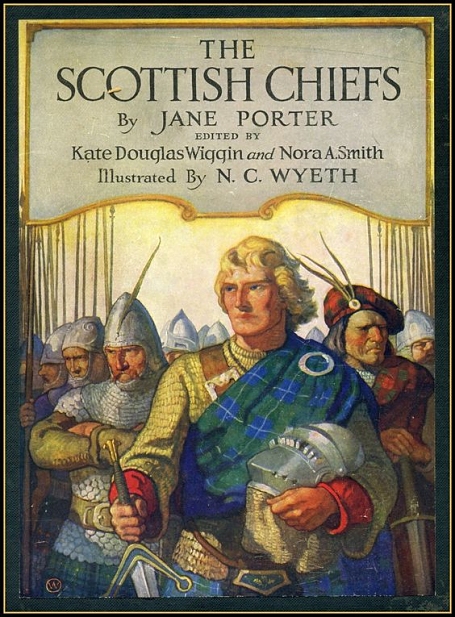The Life and Heroick Actions of the Renoun'd Sir William Wallace,
General and Governour of Scotland
by William Hamilton of Gilbertfield
Synopsis (Continued)
The King of France, hearing of Wallace's achievements, wonders how a man with so little power can make the English retreat and ask for a truce. He sends a messenger to Wallace, who finds him in Ayr. The messenger tells Wallace that the King of France admires his honor and bravery so much that he intends to advance Wallace "as high as any subject born in France."
The messenger stays in Ayr for twenty days, entertained with feasting, sport and plays. Wallace then gives the messenger his reply and gifts, and accompanies him to the coast and sees him off. Wallace prepares for his own future voyage to France by naming Lord James Stuart, who is the Steward of Scotland, as the Governor as well.
The messenger, on his return to France, presents the King with Wallace's reply: Due to the continued strife with England, he's unable to come immediately, but if still alive in a year, he will come to France and meet with the King.
Wallace departs to France from Kirkcudbright, taking fifty "stout Scottish Gentlemen" with him, among whom are four of his own family: two Wallaces, Crawford and Cleland. On the morning of the second day of their journey the ship master sees sixteen ships sailing a steady course toward them. The ship master, recognizing the red sails as those belonging to a pirate called the Red Reiver, fears for his life and informs Wallace that the Red Reiver kills all he comes across, no matter what offer is made to him.
Wallace asks how he might recognize the Red Reiver, and the ship master describes him: A handsome man, taller than most, dressed in red over mail, with a shield of red, white and blue; the red for blood and hardiness, white for courage and blue because he is a Christian. He warns Wallace that the Red Reiver is in the lead ship and will hail them, and then strike quickly. Wallace tells the ship master "this is no Christian deed," and orders him to get below decks.
The ship master and steermen go below while Wallace's men dress in armor. Forty-eight stay on the deck with Crawford, while Cleland takes the helm. Wallace tells them that when the Red Reiver's ship draws up, they will drop their sail, attack, and at Wallace's command draw up the sail again.
As the Red Reiver boards their ship Wallace grabs him by the throat and throws him to the deck, drawing a knife. The Red Reiver cries out for mercy, saying he will mend his ways, and begging Wallace in Latin to spare his life. Wallace takes his weapons and makes him swear on his sword that from that day forth he will do no wrong, and to command his men to peace. (Here presents a major incongruity in the time period in which this version of Blind Harry's Wallace was written: This scene would have taken place in the late 13th century, but Gilbertfield has Wallace commanding The Red Reiver to tell his men to "cause their shot of guns to cease.")
The Red Reiver gives his name as Thomas of Longoveil (Longueville), and explains that he is a Frenchman who became a pirate by mischance, having killed a man with one stroke in a "sudden strife." He escaped France with the help of friends in court and, unable to obtain a pardon, seized an English ship; for the past sixteen years he has been at sea, shedding much blood. Wallace says Scotland has great need of men like Longueville, and Longueville is impressed that he and all his ships were captured single-handedly. Wallace tells him that as a reward for answering the King's request to come to France he will ask for a pardon for Longueville. Longueville responds by vowing to serve Wallace faithfully for all his days. Wallace replies that service is not necessary, but he will value friendship.
They arrive in Rochelle (La Rochelle) and the town is in fear when they see the red sails of Longueville's ships approaching. This changes to welcome when the Red Lion of Scotland is recognized. Wallace, Longueville and their men stay at Rochelle for four days before going to Paris.
In Paris, Wallace disguises Thomas of Longueville as one of his own men and presents him to the King, along with his fifty knights. The King is greatly pleased and impressed with Wallace and agrees to grant him any favor, "except my Queen or crown." Wallace asks only for peace and forgiveness for Thomas of Longueville and his fourteen hundred men. This request is granted and, in addition, the King also knights Longueville with his own hand. Longueville leaves his estate to his nearest heir and formally joins Wallace's band.
Wallace stays three weeks in Paris before becoming restless. He decides to march to Guyen (Guyenne, the archaic name for Aquitaine), a region of France under English control. With him he takes Thomas of Longueville and nine hundred Scots. They set about harrassing the countryside, destroying forts and castles, putting many Englishmen to death.
They ride to Scemen (possibly Chinon, or Cenon,) a town garrisoned by the English that is located on the water within a "park" that was long and wide. Wallace takes four hundred men with him; the remaining five hundred stay with Crawford, lying in ambush. Wallace and his men draw the English out by riding past the town flying the Scottish banner; a battle ensues. "Vast numbers" of English lose their lives, and a few Scots. Crawford brings his force out of hiding and the English are driven back into the town. Wallace and fifteen Knights chase after them, and are trapped when the portcullis is dropped. They fight with their backs to the wall until Richard Wallace climbs the wall, kills the porter and raises the portcullis. The Scots kill all in the town who have a sword or weapon in hand, spare the others, and seize the goods and riches. The town is quickly repopulated with Frenchmen, and Wallace with his men return to the field.
When news of the victories against the English in Guyen reaches the King of France he raises an army twenty thousand strong led by his brother, the Duke of Orleance (Orleans.) They quickly march to join up with Wallace, and take the town of Burdeos (Bordeaux) without a fight. Word is sent from the citizens of Bordeaux to Picardy, telling of Wallace and the new army.
The Earl of Gloucester, then in charge at Calais, returns to England and informs the Parliament that Wallace has broken the truce. Lord Beaumont replies that he hasn't, stating that Wallace is for Scotland only, not for France. Woodstock insists that Wallace has broken the peace, and King Edward is persuaded by his argument that the time is right to make war on Scotland.
A force is quickly raised, with Gloucester leading the vanguard, Longcastle the main force, and Vallange, who was well known in the north, attempting to convert many to the King's cause. He has some success taking Dundee and lands south through Northumberland to the coast. Sir John Psewart (Siward) goes by sea to claim St. Johnstoun (Perth) and all of Fife for the English.
Adam Wallace flees to Rauchry (Rathlin), Robert Boyd flees to the island of Bute; Sir John the Graham escapes to the forest of Clyde; Lundie steals away from Fife to Dundaff Moor. Regrouping and rallying under Lundie and Graham the Scots take Bothwell Castle, claiming gold and goods.
Squire Guthrie goes by sea at Aberbrothwick to Sluce (possibly the sluice gates of an unnamed French town) where he tells Wallace the disheartening news. Wallace swears never to have peace again with the English King. He calls upon the King of France to allow him freedom to go to Scotland and fight the southern foe. The King agrees, providing Wallace will agree to return quickly to France when the battle is won.
Wallace leaves for Flanders, accompanied by Thomas of Longueville and his men, and travels on to Montrose where they meet up with Sir John Ramsay, Ruthven, Barclay and Bisset and their three hundred men, and then march to Ochter House.
The ballad, The Life and Heroick Actions of the Renoun'd Sir William Wallace, General and Governour of Scotland, by William Hamilton of Gilbertfield, 1722, is in the public domain.

The Kingdom of England and the Kingdom of Scotland fought dozens of battles with each other. They fought typically over land, particularly Berwick-Upon-Tweed, and the Anglo-Scottish border frequently changed as a result. Read more at Wikipedia.

The First War of Scottish Independence was the initial chapter of engagements in a series of warring periods between English and Scottish forces lasting from the invasion by England in 1296 ... Read more at Wikipedia.

Digitized version of The Scottish Chiefs, by Jane Porter, a novelization published in 1921 by Charles Scribner's Sons, about William Wallace and the First Scottish War of Independence. Read online at archive.org.